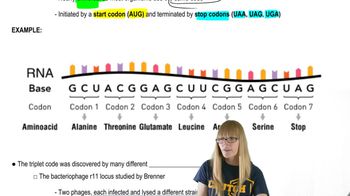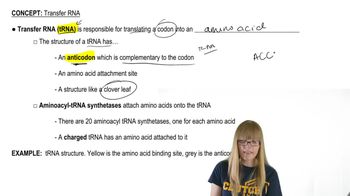The human mitochondrial genome encodes only 22 tRNAs, but at least 32 tRNAs are needed for cytoplasmic translation. How are all codons in mitochondrial transcripts accommodated by only 22 tRNAs? The Plasmodium mitochondrial genome does not encode any tRNAs; how are genes of the Plasmodium mitochondrial genome translated?
Table of contents
- 1. Introduction to Genetics51m
- 2. Mendel's Laws of Inheritance3h 37m
- 3. Extensions to Mendelian Inheritance2h 41m
- 4. Genetic Mapping and Linkage2h 28m
- 5. Genetics of Bacteria and Viruses1h 21m
- 6. Chromosomal Variation1h 48m
- 7. DNA and Chromosome Structure56m
- 8. DNA Replication1h 10m
- 9. Mitosis and Meiosis1h 34m
- 10. Transcription1h 0m
- 11. Translation58m
- 12. Gene Regulation in Prokaryotes1h 19m
- 13. Gene Regulation in Eukaryotes44m
- 14. Genetic Control of Development44m
- 15. Genomes and Genomics1h 50m
- 16. Transposable Elements47m
- 17. Mutation, Repair, and Recombination1h 6m
- 18. Molecular Genetic Tools19m
- 19. Cancer Genetics29m
- 20. Quantitative Genetics1h 26m
- 21. Population Genetics50m
- 22. Evolutionary Genetics29m
11. Translation
Translation
Problem 5
Textbook Question
During translation, what molecule bears the codon? the anticodon?
 Verified step by step guidance
Verified step by step guidance1
Understand that translation is the process where the genetic code carried by mRNA is decoded to produce a specific polypeptide or protein.
Identify that a codon is a sequence of three nucleotides on the mRNA molecule that specifies a particular amino acid.
Recognize that the molecule bearing the codon is the messenger RNA (mRNA), which carries the genetic information from DNA to the ribosome.
Know that the anticodon is a sequence of three nucleotides on the transfer RNA (tRNA) molecule that is complementary to the mRNA codon.
Therefore, the molecule bearing the anticodon is the tRNA, which brings the appropriate amino acid to the ribosome during protein synthesis.
 Verified video answer for a similar problem:
Verified video answer for a similar problem:This video solution was recommended by our tutors as helpful for the problem above
Video duration:
1mPlay a video:
Was this helpful?
Key Concepts
Here are the essential concepts you must grasp in order to answer the question correctly.
Codon
A codon is a sequence of three nucleotides on messenger RNA (mRNA) that specifies a particular amino acid during protein synthesis. Each codon corresponds to one amino acid or a stop signal, guiding the assembly of the polypeptide chain.
Recommended video:
Guided course

The Genetic Code
Anticodon
An anticodon is a set of three nucleotides on transfer RNA (tRNA) that is complementary to a specific mRNA codon. The anticodon allows the tRNA to recognize and bind to the correct codon, ensuring the correct amino acid is added to the growing protein.
Recommended video:
Role of mRNA and tRNA in Translation
During translation, mRNA carries the codons that encode the protein sequence, while tRNA molecules carry amino acids and use their anticodons to match the mRNA codons. This interaction ensures accurate decoding of genetic information into proteins.
Recommended video:
Guided course

Translation initiation

 7:58m
7:58mWatch next
Master Translation initiation with a bite sized video explanation from Kylia
Start learningRelated Videos
Related Practice
Textbook Question
565
views

